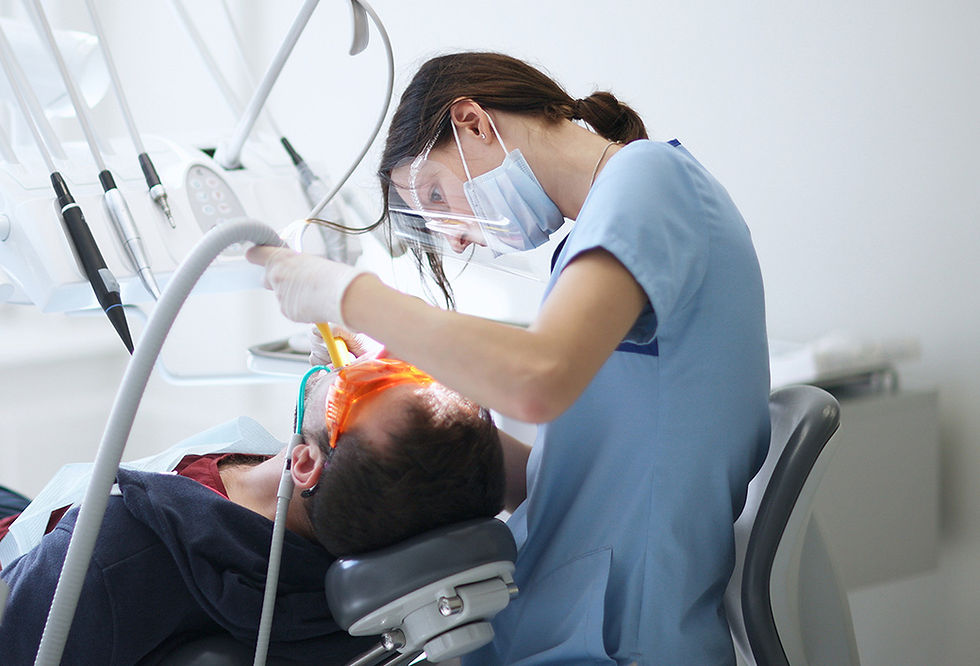The Power of Brushing: Are You Doing It Right?
- Steve Hoang Anh

- Jul 1
- 3 min read
Brushing your teeth is one of the most fundamental habits we learn as children. It’s a ritual repeated every morning and night, often so routine that we forget its real purpose. But here’s the truth: brushing your teeth properly isn’t just a hygiene checklist—it’s the foundation for a lifetime of healthy smiles.
Despite its simplicity, many people don’t brush correctly. Either they rush through it, apply the wrong technique, or use tools that aren’t ideal for their oral health. Let’s revisit this seemingly basic habit and uncover how a few mindful changes can make a big difference.

Why Brushing Matters More Than You Think
Our mouths are filled with bacteria—some harmless, others not so much. When food particles and sugars stay on your teeth, they feed these bacteria, producing acids that wear away enamel and lead to cavities. Brushing removes plaque before it hardens into tartar, which can’t be cleaned by a regular toothbrush. It also freshens breath, prevents gum disease, and plays a major role in your overall health. Studies have even linked oral hygiene to heart health and diabetes management.
So no, brushing isn’t just about having a clean smile. It’s about safeguarding your health from the inside out.
Common Mistakes You Might Be Making
Let’s be honest: we’ve all had those sleepy late nights or busy mornings where brushing becomes more of a checkbox than a careful habit. But how we brush matters.
One of the biggest mistakes is brushing too quickly. Most people brush for less than a minute, when the recommended time is two full minutes. Another common issue is using a hard-bristled toothbrush or applying too much pressure, thinking it will clean better. In reality, this can wear down enamel and irritate gums.
Brushing immediately after acidic meals, like citrus or soda, can also do more harm than good by spreading acid across weakened enamel. And while electric toothbrushes can be great tools, using them without guidance can still lead to missed spots if technique is poor.
The Right Way to Brush, Step by Step

First, make sure you’re using a toothbrush with soft bristles and fluoride toothpaste. Angle your brush at 45 degrees toward your gum line and use gentle, circular motions. Work methodically—start with the outer surfaces of your teeth, then the inner surfaces, followed by chewing surfaces. Don’t forget to gently brush your tongue, as it harbors bacteria that can cause bad breath.
Time yourself to ensure you hit that two-minute mark. A timer or electric toothbrush with a built-in alert can make it easy. And always rinse your brush thoroughly after use and let it air dry upright.
Choosing the Right Tools for the Job
A toothbrush might seem like just a toothbrush—but there's more variety than most people realize. If you have sensitive gums or enamel, soft bristles are a must. For better cleaning efficiency, many dentists recommend electric toothbrushes, especially for those with limited dexterity or braces.
Fluoride toothpaste is essential. It strengthens enamel and makes teeth more resistant to decay. But if you have specific concerns like sensitivity or tartar buildup, look for a formula tailored to your needs. And remember: even the best toothbrush wears out. Replace yours every 3 months—or sooner if the bristles are frayed.
Beyond Brushing: A Complete Routine
Brushing is just one pillar of your oral care routine. To truly protect your teeth and gums, combine it with flossing once a day and rinsing with an antibacterial mouthwash. Brushing only cleans about 60% of tooth surfaces; flossing reaches the tight spaces between your teeth and along the gum line.
Keeping your mouth hydrated by drinking water throughout the day also helps flush away food particles and bacteria. And of course, regular checkups with your dentist—at least twice a year—ensure that any issues are caught before they become serious.
Make Brushing a Habit Worth Keeping
They say it takes about 21 days to build a habit. So if you’ve been brushing on autopilot, now’s a perfect time to reset. Make those two minutes in front of the mirror count. Play music. Use a brushing app. Invest in a toothbrush you enjoy using. Make oral care not just a routine—but a form of self-care.
When you treat your teeth with care and attention, they repay you in confidence, comfort, and long-term health.
Final Thoughts
Brushing your teeth might be a simple act, but it carries powerful benefits that stretch far beyond a sparkling smile. With the right technique, tools, and consistency, you can transform your oral health and protect it for years to come. It’s never too late to improve your brushing habits—and your future self will thank you for it.



Comments